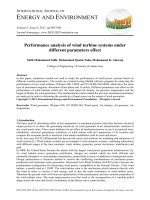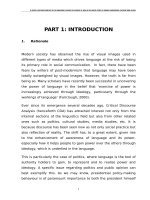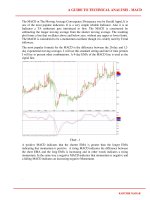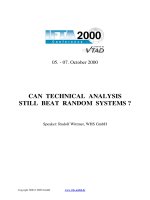Can technical analysis still beat random systems (2000)
Bạn đang xem bản rút gọn của tài liệu. Xem và tải ngay bản đầy đủ của tài liệu tại đây (1.11 MB, 22 trang )
Copyright 2000 © WHS GmbH www.whs-gmbh.de
05. - 07. October 2000
CAN TECHNICAL ANALYSIS
STILL BEAT RANDOM SYSTEMS ?
Speaker: Rudolf Wittmer, WHS GmbH
Copyright 2000 © WHS GmbH www.whs-gmbh.de 2
CONTENTS
Acknowledgements
The Problem
The Solution
Key System Performance Numbers
Monte Carlo Simulation
Synthetic Data
Random Systems
Conclusion
Copyright 2000 © WHS GmbH www.whs-gmbh.de 3
“Live (markets) can only understood backwards,
but it (they) must be lived (traded) forwards.”
SÖREN KIERKEGAARD, Danish Philosopher
Copyright 2000 © WHS GmbH www.whs-gmbh.de 4
Acknowledgements
This manual could not have been written without the assistance of the following software:
Omega Research
Trading Strategy Backtesting Software: TradeStation
www.omegaresearch.com
RINA Systems
Development of Performance Analysis Software: Portfolio Evaluator, Money Manager
www.rinasystems.com
AnalyCorp (Dr. Savage)
Business Analysis Software for Microsoft Excel: Insight.xla
www.analycorp.com
Tradeworks software
Random Number Generator by Dave de Luca
Inside Edge Systems, Inc.
Portfolio Monte Carlo Simulation by Bill Brower
www.insideedgesystems.com
Copyright 2000 © WHS GmbH www.whs-gmbh.de 5
1. The Problem
“Progress in knowledge results more from efforts to find faults with our
theories, rather than prove them.”
SIR KARL POPPER, Austrian Philosopher
Technical Analysts often find a system or technical method that seems
extremely profitable and convenient to follow - one that they think has been
overlooked by the professionals. Sometimes they are right, but most often that
method doesn't work in practical trading or for a longer time.
Technical analysis uses price and related data to decide when to buy and sell.
The methods used can be interpretive as chart patterns and astrology, or as
specific as mathematical formulas and spectral analysis. All factors that
influence the markets are assumed to be netted out as the current price.
Figure 1: Random generated data with 200-Moving Average
On the other side it has been the position of many fundamental and economic
analysis advocates that there is no sequential correlation between the direction
of price movement from one day to the next.
Copyright 2000 © WHS GmbH www.whs-gmbh.de 6
Even if the markets were random, people fail to understand randomness. When a
long trend does occur in a random sequence, people assume that it is not
random.
They develop theories to suggest that it is something other than a long series in a
random sequence. This tendency comes from our natural inclination to treat the
world as if everything were predictable and understandable. As a result, people
seek patterns where none exist and assume the existence of unjustified
relationships.
The following parts will show the results of some investigations done by the
author regarding the random behaviour of price data and system results. There
were three main topics:
a. The fundamental issue of technical trading systems evaluation is to answer
the questions: How much did the result of the trading system differ from a
randomly selected set of trading signals and how much did the results differ
from an available benchmark?
b. Many technical based systems fail to meet expectations when used in trading
even though they performed very well on historical data or in practical
trading before. This can happen because of changing market conditions or -
in the case of backtesting only - because of insufficient testing.
c. Measuring the risk /reward - profile of a system may sound somewhat trivial.
At a closer inspection, however, various issues arise, affecting the
comparison between different systems or the probability for the future
outcomes of a system.
Copyright 2000 © WHS GmbH www.whs-gmbh.de 7
2. The Solution
“I like the Japanese philosophie where you ask questions rather than look for
answers. The more questions you come up with the better. The answers will
happen.”
SUNNY HARRIS, Trader
There are some different ways to get reliable numbers on the stability and the
mathematical expectation of a system:
• Finding a profitable strategy in a historic backtest does not guarantee any
measure of success in the future but at least there is a better chance that the
strategy will make money going forward than the strategy which has
consistently demonstrated a propensity to fail. Still the profitable strategy
must be assessed to see if it meets the investors risk/reward - profile. We can
compute probability risk/reward - profiles using a statistical method called
Monte Carlo Simulation (MCS).
• One way to evaluate a system on a market is to test it on simulated or
synthetic data. Using synthetic data, a trader can test systems on price files
that have been simulated from any underlying market. The need for extensive
system testing on simulated (other names are synthetic, scrambled) data is
widely discussed in several books.
• A given system can be compared with a system that was generated on the
basis of a random number generator. That means that the entry signals were
generated by chance only.
Copyright 2000 © WHS GmbH www.whs-gmbh.de 8
3. Key System Performance Numbers
“It is not only fine feathers that make fine birds.”
AESOP
A mechanical system should teach you proper principles of trading. In the case
of trendfollowing systems it teaches you to go in the direction of momentum. In
Figure 2 you can see the equity-curves (in points) for a trendfollwing system on
the DAX in comparison with the underlying Cash-DAX. The system was
implemented on the historical database over the last ten years.
In Figure 3 you can see the same system implemented on the S&P 500 (again
the Cashindex is used for the study).
While the system on the DAX shows a high correlation with the underlying, the
same trading logic failed on the S&P 500 nearly all the time.
Figure 2: DAX – Index vs. System (in points)









